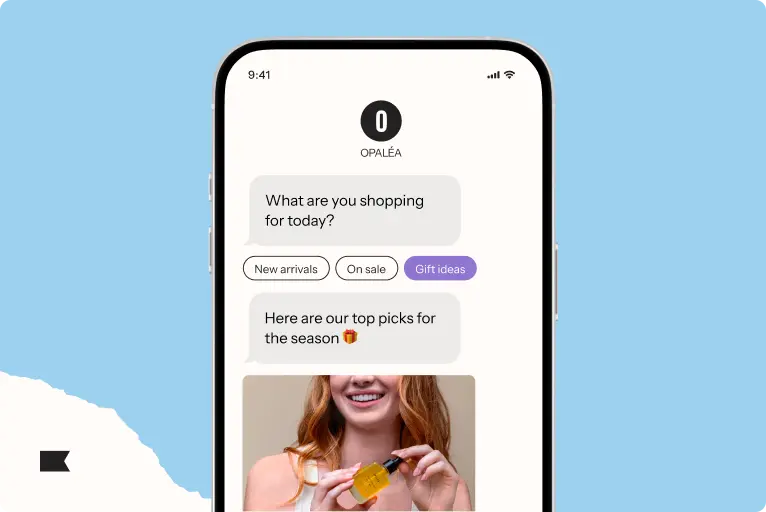When you should add an SMS short code: understanding your text message marketing options

Ever signed up for a brand’s texts or SMS marketing updates?
Then you’ve probably noticed messages are coming from a number that doesn’t look like the others.
These abbreviated numbers are called “short codes” or “common codes,” and they serve a unique purpose in SMS marketing.
Short codes are a great way for a business to send targeted and personalized text messages to a lot of subscribers. This helps marketers scale up on their owned channel strategies with SMS marketing automations that make execution a lot easier.
But first, you need to understand the difference between a dedicated short code, vanity code, 10DLC number, toll-free number…oh my. Each comes with different send rates, pricing, approval time, and more.
Want more on SMS marketing? We’ve got you covered, with articles that dive deep into:
- What is SMS marketing?
- The top 10 SMS integrations
- SMS marketing best practices from the experts
- The crawl, walk, run approach to building an SMS marketing strategy
- 16 high-impact SMS plays for boosting ROI
What is an SMS short code?
An SMS short code is a 5- or 6-digit phone number that businesses use instead of a 10-digit number for SMS marketing campaigns. These short codes are great for high-volume, mass text messaging for two key reasons:
- They have a fast per-second send rate.
- Due to the strict approval process and opt-in, they are filtered less by carriers.
Short code numbers are easily recognizable because they’re shorter than regular cell phone numbers. You also have the option of leasing a vanity code, which allows you to choose your own number—one that’s relevant for your brand or a campaign (more on this next).
Note that brands used to be able to get less expensive shared short codes, which allowed multiple businesses to use the same SMS short code. These, however, were phased out by major US wireless carriers in 2021.
What are my options if I don’t want a standard SMS short code?
Beyond a standard short code, your options include:
1. A vanity code
A vanity code is a 5- to 6-digit SMS short code you choose. For example, if you’re a jewelry company, you may want something like 74463 to spell out “SHINE.”
2. 10DLC number
A 10DLC number, or 10-digit long code, is more affordable than a short code. But it’s slower to send and has a higher risk of carrier filtering, because carriers haven’t vetted it like they do with a short code. Some brands purchase more than one 10DLC number to make up for the slower send rate.
Important note: Klaviyo no longer offers 10DLC in the US or Canada. In those countries, we only offer short codes and toll-free numbers (more on those next). In the UK, Australia, and Ireland, we support country-specific long codes.
3. Toll-free number
Compared with 10DLC numbers, 10-digit toll-free numbers have higher throughput. This may be the best option if you’re growing your SMS marketing program and aren’t quite ready to commit to a short code.
| SMS short code | 10DLC | Toll-free | |
| Length | 5-6 digits | 10 digits | 10 digits |
| Number of SMS subscribers | Recommended for 15K-30K; strongly recommended for 30K-50K | <15K | <15K |
| Approval time | Several weeks | 3-7 business days | 3-7 business days |
| Message filtering | Minimal | Moderate | Moderate |
Why short codes = peak SMS marketing performance
If you’re just testing the waters with your SMS marketing efforts, a toll-free number is a fine option. However, as your subscriber list grows or you want to send images and GIFs (MMS) to a wider audience, short codes offer some clear benefits:
If you’re also advertising with print, radio, etc., vanity short codes are an especially good option. And you can easily create different keywords to know which marketing channels are working and which aren’t (more on this later).
When someone sees a message from a short code on their cell phone, they know it’s coming from a business or organization, not someone they know.
People can look up your SMS short code in a directory, which gives your text campaigns more legitimacy.
Short codes are designed for large-scale sends, offering greater reliability and speed compared to toll-free numbers (TFNs). Because they’re pre-vetted, short codes are less likely to face carrier filtering or blocks, ensuring your messages reach more customers. They also handle high-volume MMS (images and GIFs) better, making them ideal for media-rich campaigns. For flash sales or time-sensitive promotions, short codes provide the speed and dependability needed to maximize impact.
Short codes can only send or receive text messages. You can’t use them for phone calls or faxes, so you don’t have to worry about recipients trying to use it outside the purpose of SMS.
4 SMS short code best practices
Short codes are about providing an excellent customer experience. Here are 4 SMS short code best practices for achieving that:
1. Understand local SMS compliance laws
It’s important for your SMS campaigns to be in compliance with the local laws where you do business. Make sure your business complies with the Telephone Consumer Protection Act (TCPA), Cellular Telecommunications Industry Association (CTIA), and other messaging authorities.
Whether you send from a short code or a long number, always respect your customers’ privacy and honor their opt-in and opt-out requests. Never spam or send unwanted messages.
2. Use vanity short codes for memorable brand messages on other channels
Vanity short codes can be a great way to create a memorable number that your customers can text to opt in to campaigns, contests, discounts, and much more.
This versatility is often worth the extra cost. Because they’re typically easier to remember than a string of numbers, vanity codes can be used in print campaigns, billboards, digital campaigns, radios, podcasts, and other marketing channels. This can help you create unique customer experiences through SMS.
3. Make it obvious SMS messages are from your brand
Mention your brand name in your messages, whether you’re sending from a long or short number. Most people don’t save businesses to their contact list. When you send branded text messages, customers never have to guess where they’re coming from.
4. Use keywords in your short code texts
Tracking return on investment (ROI) is vital to the success of any marketing campaign. To attribute revenue back to your SMS campaigns and flows, use custom keywords to track where your subscribers are coming from.
For example, you may say:
- “Text FB to 34267 to get an exclusive offer” on Facebook
- “Text ENTER to 34267 to enter our giveaway” if you’re trying to grow your SMS list through a contest or giveaway
Next steps: How to get a short code or toll-free number
If you’re using Klaviyo for SMS marketing, the first step is to fill out the short code application form.
You will need to determine if you want a random or vanity short code. For vanity short codes, see what’s available by checking the US Short Code Registry, which is overseen by the CTIA, the wireless trade association.
Be sure to prepare examples of text messages you plan to send for review by the mobile carriers, as well as general business information, including:
- Business name
- Business address
- Primary contact’s name, email, and phone number
- Support phone number and/or email address
Provisioning a new short code can take several weeks. For more detail on securing an SMS short code, visit our help center.
To get a verified toll-free number, sign up for Klaviyo SMS and get one for free.
SMS short code FAQs
How do I find out who owns a short code?
You can look up an SMS short code owner in the US short code directory. Click on the search icon and enter the short code to look up who owns it.
How do I get a short code for SMS?
You can get an SMS short code by applying with the US Short Code Registry, but if you use Klaviyo for SMS marketing, we’ll help you.
What is a short code lookup service or short code registry?
A short code lookup service is a short code registry or SMS registry you can access online to find out who is sending you text messages. Because Klaviyo provisions short codes for our customers, the only reason you would need to do a short code lookup is to check if the number you want is available before application.
What is the difference between an SMS long code vs. short code?
First, short codes deliver messages much faster. Second, since short codes require pre-approval, carriers trust messages from short codes more than other number types and are less likely to filter your texts. Finally, short codes build trust with your audience because consumers tend to associate short codes with vetted brands.
How much does an SMS short code cost?
It depends on the type of short code and your SMS marketing platform. With Klaviyo, for example, a vanity short code costs $1,150/month in the US and $1,000/month in Canada, while a random short code costs $500/month.
Do SMS short codes work in other countries?
No, SMS short codes do not work in other countries. You’ll need to apply for separate short codes in separate countries. For example, your US short code will not work in Canada. You’ll need to apply for a separate Canadian short code.
How do users opt in or out of SMS?
Users opt in to SMS by giving explicit permission through sign-up forms or links. With double opt-in, the subscriber receives a message that asks them to confirm their consent with a keyword (for example, “Reply YES to confirm your subscription”). To opt out, users can text a keyword (usually “STOP”) to unsubscribe—something that, by law, the brand must make clear in each text message.

Related content

Looking for the best SMS marketing tools? See the top 3 platforms for 2026 and learn how to choose the right one for segmentation, automation, and two-way messaging

Marketers are right to be cautious right now. The Texas settlement has sparked more questions than clarity—but that’s exactly why taking a compliance-first approach still matters.

Google’s RCS Roadshow and Klaviyo are shaping the future of mobile marketing with AI-powered personalization and trusted, interactive messaging.